starter KIA CARNIVAL 2007 Workshop Manual
[x] Cancel search | Manufacturer: KIA, Model Year: 2007, Model line: CARNIVAL, Model: KIA CARNIVAL 2007Pages: 1575, PDF Size: 44.86 MB
Page 71 of 1575

INSTALLATION
Installation is in the reverse order of removal.
Perform the following :a. Adjust the shift cable.
b. Refill the engine with engine oil.
c. Refill the transaxle with fluid.
d. Refill the radiator with engine coolant.
e. Bleed air from the cooling system with the heater valve open.
f. Clean the battery posts and cable terminals with sandpaper assemble them, then apply grease to prevent
corrosion.
g. Inspect for fuel leakage.
After assembling the fuel line, turn on the ignition switch (do not operate the starter) so that the fuel pump runs for
approximately two seconds and fuel line pressurizes.
Repeat this operation two or three times, then check for fuel leakage at any point in the fuel line.
Page 141 of 1575

2007 > 2.7L V6 GASOLINE >
THE MICRO 570 ANALYZER
The MICRO 570 Analyzer provides the ability to test the charging and starting systems, including the battery, starter
and generator.
Because of the possibility of personal injury, always use extreme caution and appropriate eye protection when
working with batteries.
KEYPAD
The MICRO570 button on the key pad provides the following functions :
BATTERY TEST PROCEDURE
1.Connect the tester to the battery.
a. Red clamp to battery positive (+) terminal.
b. Black clamp to battery negative ( - ) terminal.
Connect clamps securely. If "CHECK CONNECTION" message is displayed on the screen, reconnect clamps
securely.
Page 143 of 1575

The battery ratings (CCA) displayed on the tester must be identical to the ratings marked on battery label.
6. To conduct starter test, press ENTER.
BATTERY TEST RESULTS
RESULT ON PRINTER REMEDY
Good battery No action is required
Good recharge Battery is in a good state
Recharge the battery and use
Charge & Retest Battery is not charged properly
=> Charge and test the battery again (Failure to charge
the battery fully may read incorrect measurement value)
Replace battery => Replace battery and recheck the charging system.
(Improper connection between battery and vehicle cables
may cause "REPLACE BATTERY", retest the battery
after removing cables and connecting the tester to the
battery terminal directly prior to replacing the battery)
Bad cell- replace => Charge and retest the battery. And then, test results
may cause "REPLACE BATTERY", replace battery and
recheck the charging system
Whenever filing a claim for battery, the print out of the battery test results must be attached.
STARTER TEST PROCEDURE
1.
After the battery test, press ENTER immediately for the starter test.
Page 144 of 1575
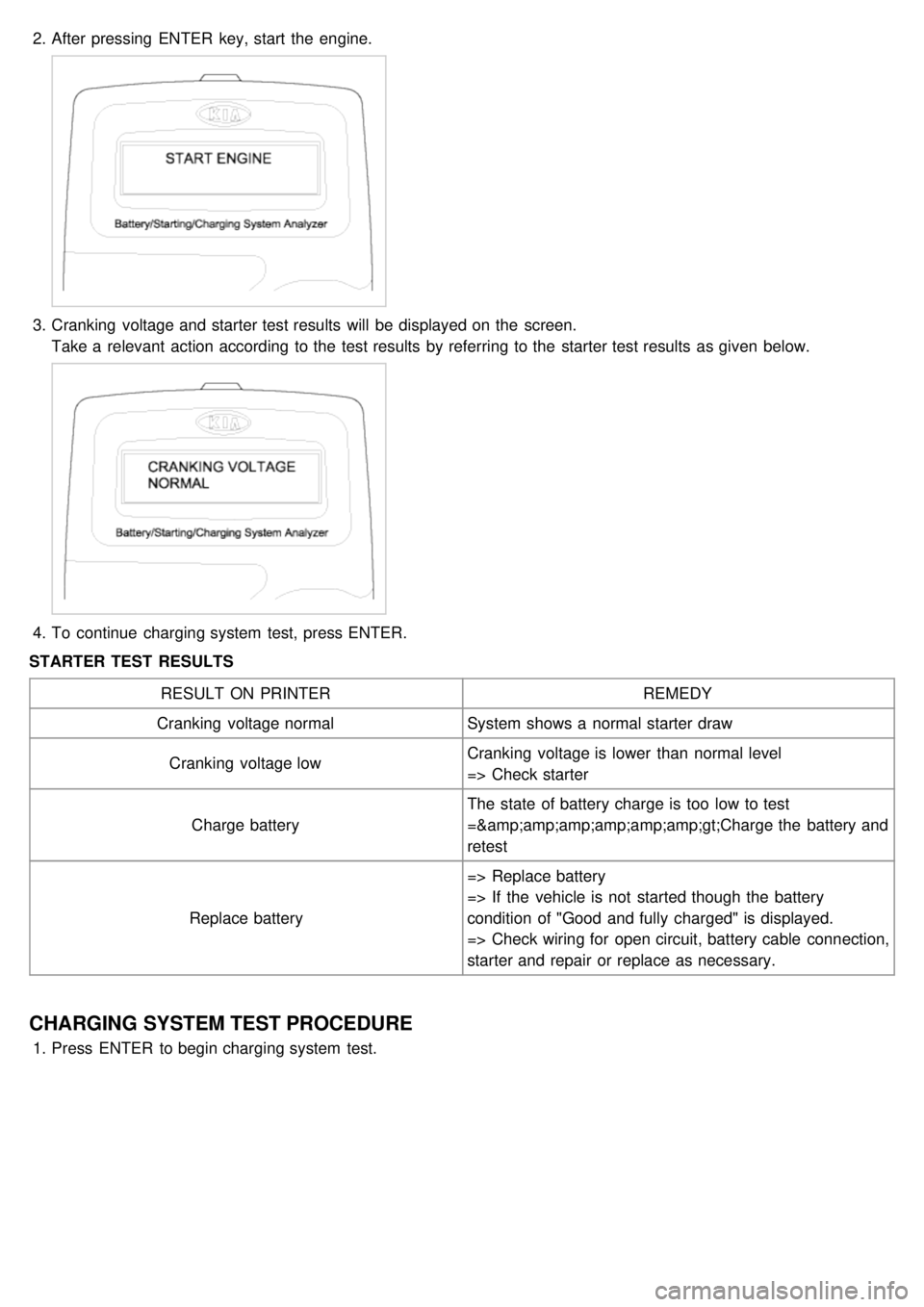
2.After pressing ENTER key, start the engine.
3.Cranking voltage and starter test results will be displayed on the screen.
Take a relevant action according to the test results by referring to the starter test results as given below.
4.To continue charging system test, press ENTER.
STARTER TEST RESULTS
RESULT ON PRINTER REMEDY
Cranking voltage normal System shows a normal starter draw
Cranking voltage low Cranking voltage is lower than normal level
=> Check starter
Charge battery The state of battery charge is too low to test
=>Charge the battery and
retest
Replace battery => Replace battery
=> If the vehicle is not started though the battery
condition of "Good and fully charged" is displayed.
=> Check wiring for open circuit, battery cable connection,
starter and repair or replace as necessary.
CHARGING SYSTEM TEST PROCEDURE
1.
Press ENTER to begin charging system test.
Page 150 of 1575
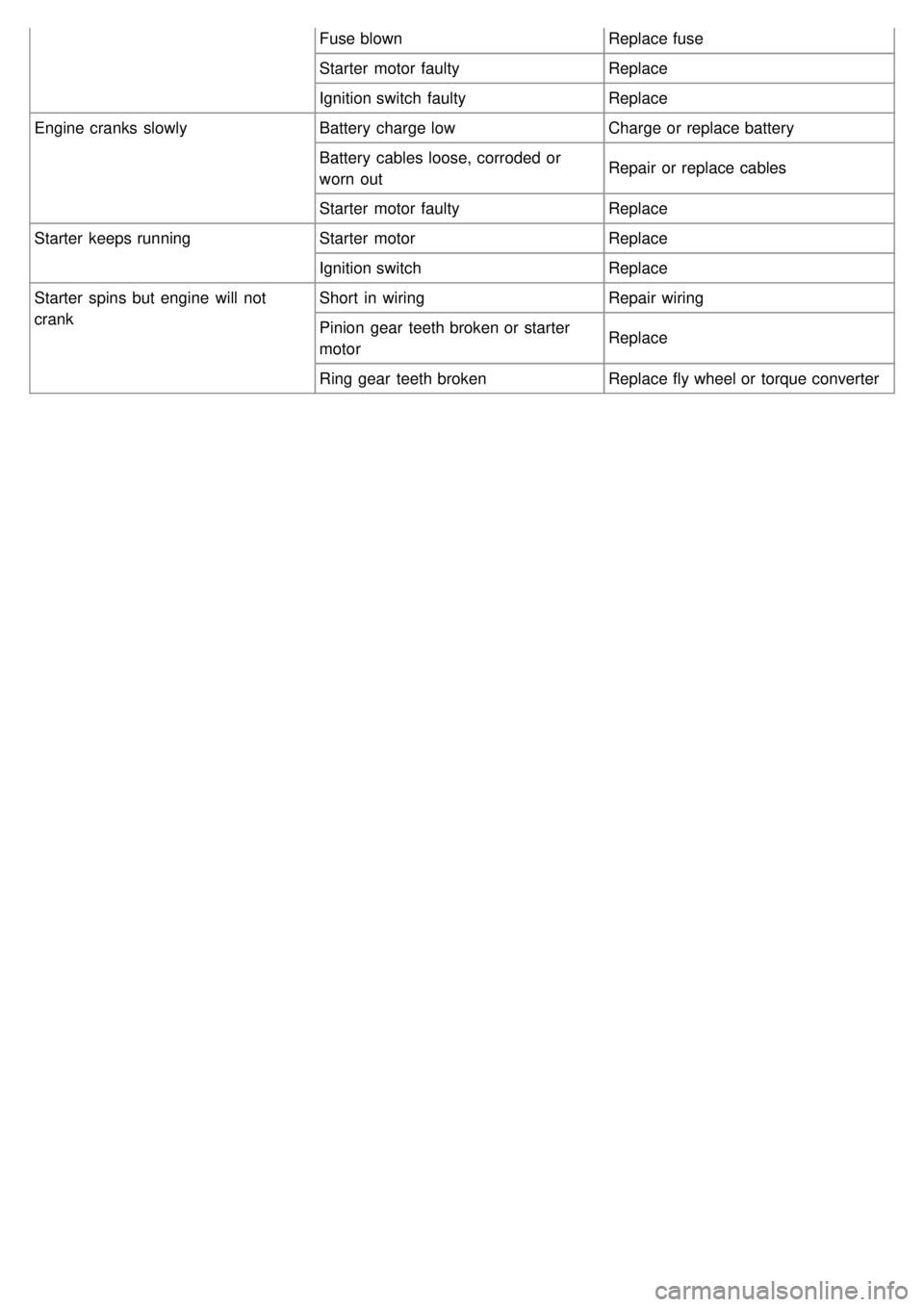
Fuse blownReplace fuse
Starter motor faulty Replace
Ignition switch faulty Replace
Engine cranks slowly Battery charge low Charge or replace battery
Battery cables loose, corroded or
worn out Repair or replace cables
Starter motor faulty Replace
Starter keeps running Starter motor Replace
Ignition switch Replace
Starter spins but engine will not
crank Short in wiring
Repair wiring
Pinion gear teeth broken or starter
motor Replace
Ring gear teeth broken Replace fly wheel or torque converter
Page 151 of 1575
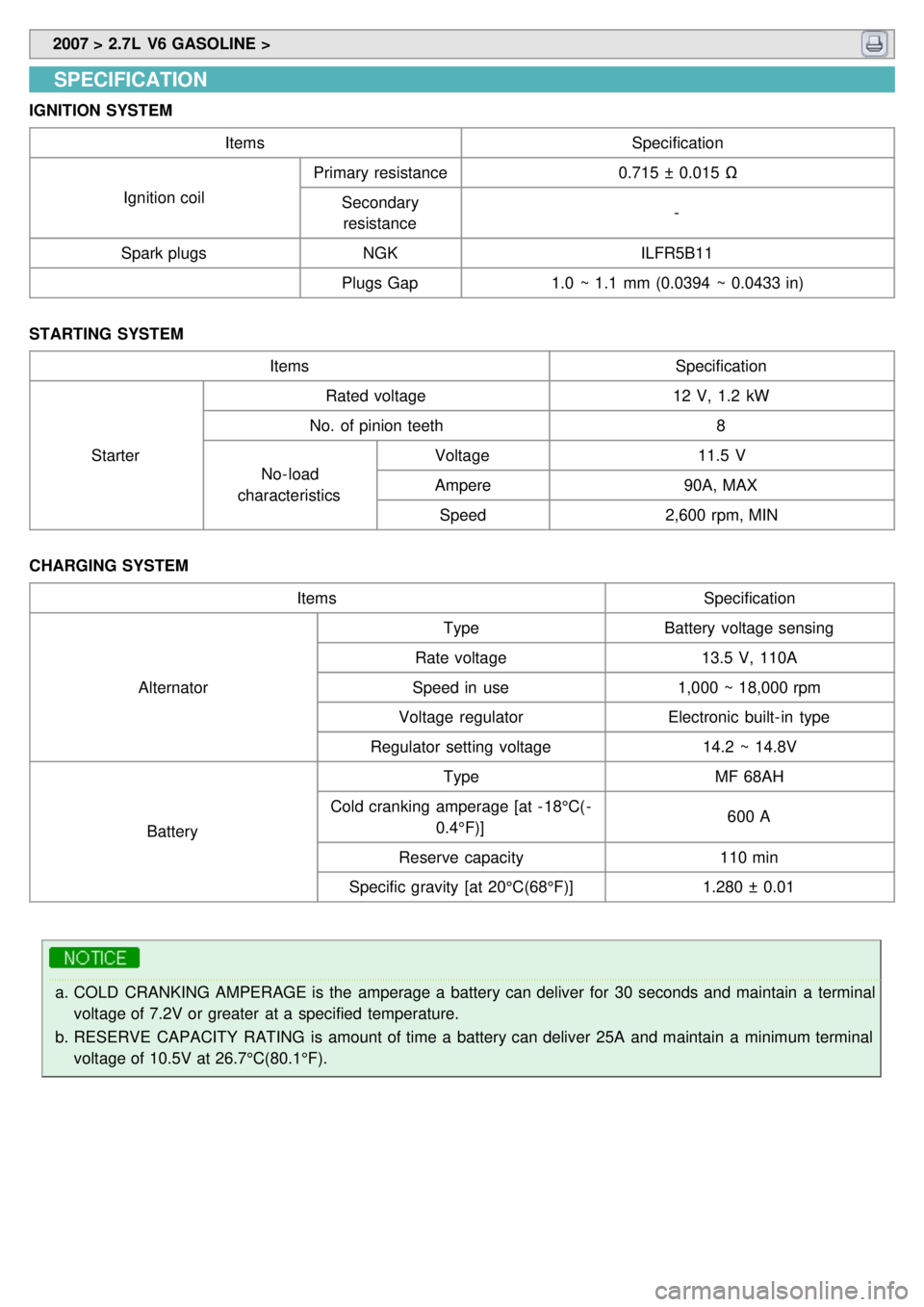
2007 > 2.7L V6 GASOLINE >
SPECIFICATION
IGNITION SYSTEM
Items Specification
Ignition coil Primary resistance
0.715 ± 0.015 Ω
Secondary resistance -
Spark plugs NGK ILFR5B11
Plugs Gap 1.0 ~ 1.1 mm (0.0394 ~ 0.0433 in)
STARTING SYSTEM Items Specification
Starter Rated voltage
12 V, 1.2 kW
No. of pinion teeth 8
No- load
characteristics Voltage
11.5 V
Ampere 90A, MAX
Speed 2,600 rpm, MIN
CHARGING SYSTEM Items Specification
Alternator Type
Battery voltage sensing
Rate voltage 13.5 V, 110A
Speed in use 1,000 ~ 18,000 rpm
Voltage regulator Electronic built- in type
Regulator setting voltage 14.2 ~ 14.8V
Battery Type
MF 68AH
Cold cranking amperage [at - 18°C(- 0.4°F)] 600 A
Reserve capacity 110 min
Specific gravity [at 20°C(68°F)] 1.280 ± 0.01
a.COLD CRANKING AMPERAGE is the amperage a battery can deliver for 30 seconds and maintain a terminal
voltage of 7.2V or greater at a specified temperature.
b. RESERVE CAPACITY RATING is amount of time a battery can deliver 25A and maintain a minimum terminal
voltage of 10.5V at 26.7°C(80.1°F).
Page 175 of 1575
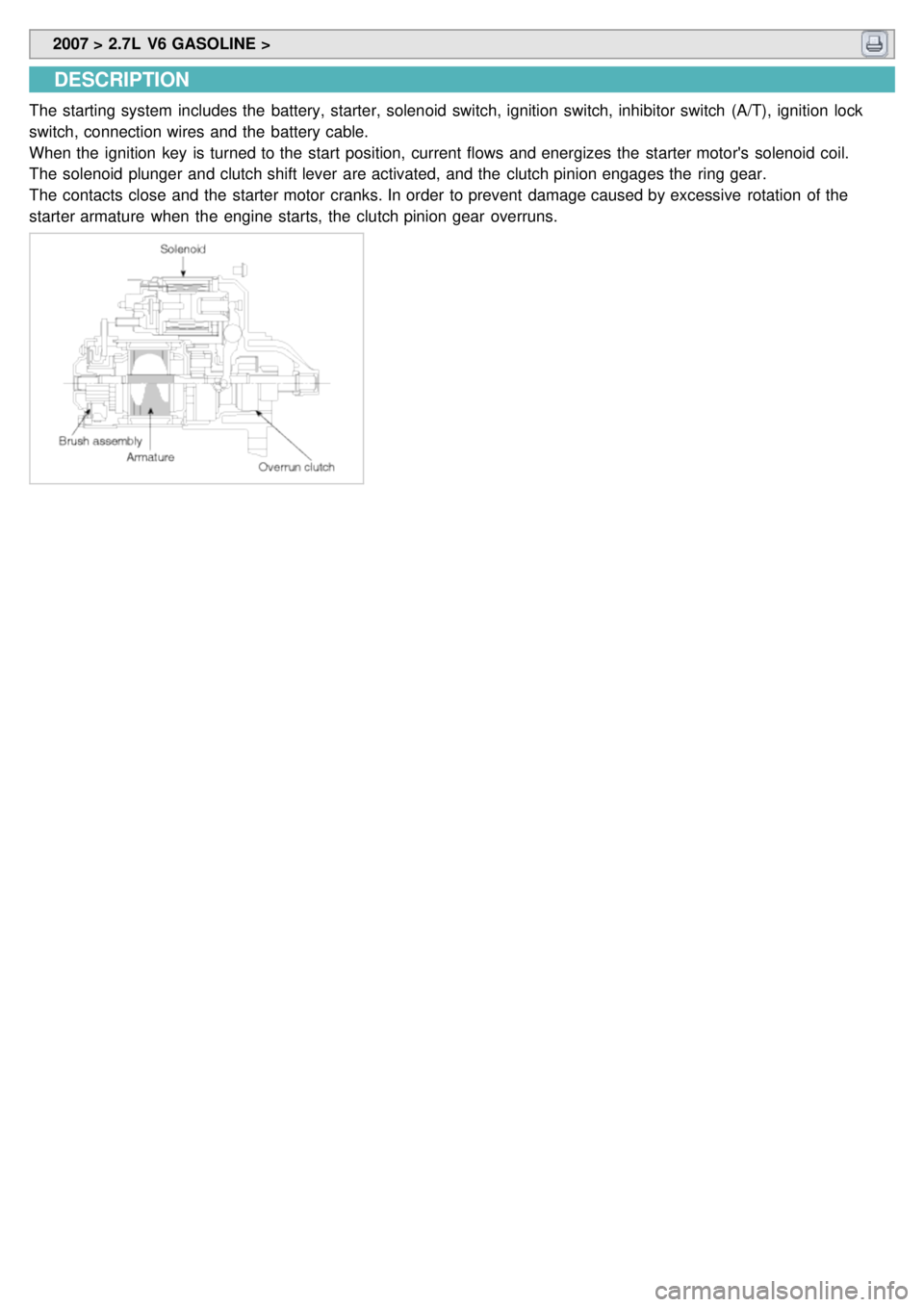
2007 > 2.7L V6 GASOLINE >
DESCRIPTION
The starting system includes the battery, starter, solenoid switch, ignition switch, inhibitor switch (A/T), ignition lock
switch, connection wires and the battery cable.
When the ignition key is turned to the start position, current flows and energizes the starter motor's solenoid coil.
The solenoid plunger and clutch shift lever are activated, and the clutch pinion engages the ring gear.
The contacts close and the starter motor cranks. In order to prevent damage caused by excessive rotation of the
starter armature when the engine starts, the clutch pinion gear overruns.
Page 176 of 1575

2007 > 2.7L V6 GASOLINE >
STARTER CIRCUIT TROUBLESHOOTING
The battery must be in good condition and fully charged.
1. Remove the fuel pump relay(A) from the fuse box.
2. With the shift lever in N or P (A/T) or clutch pedal pressed (M/T), turn the ignition switch to "START"
If the starter normally cranks the engine, starting system is OK. If the starter will not crank the engine at all, go to
next step.
If it won't disengage from the ring gear when you release key, check for the following until you find the cause.
a. Solenoid plunger and switch malfunction.
b. Dirty pinion gear or damaged overrunning clutch.
3. Check the battery condition. Check electrical connections at the battery, battery negative cable connected to the
body, engine ground cables, and the starter for looseness and corrosion. Then try starting the engine again.
If the starter cranks normally the engine, repairing the loose connection repaired the problem. The starting system
is now OK.
If the starter still does not crank the engine, go to next step.
4. Disconnect the connector from the S- terminal of solenoid. Connect a jumper wire from the B- terminal of solenoid to
the S- terminal of solenoid.
If the starter cranks the engine, go to next step.
If the starter still does not crank the engine, remove the starter, and repair or replace as necessary.
5. Check the following items in the order listed until you find the open circuit.
a. Check the wire and connectors between the driver's under - dash fuse/relay box and the ignition switch, and
between the driver's under - dash fuse/relay box and the starter.
b. Check the ignition switch (Refer to BE group - ignition system)
c. Check the transaxle range switch connector or ignition lock switch connector.
d. Inspect the starter relay.
STATER SOLENOID TEST
1.Disconnect the field coil wire from the M- terminal of solenoid switch.
2. Connect the battery as shown. If the starter pinion pops out, it is working properly. To avoid damaging the starter,
do not leave the battery connected for more than 10 seconds.
3.Disconnect the battery from the M terminal.
If the pinion does not retract, the hold- in coil is working properly. To avoid damaging the starter, do not leave the
battery connected for more than 10 seconds.
Page 177 of 1575
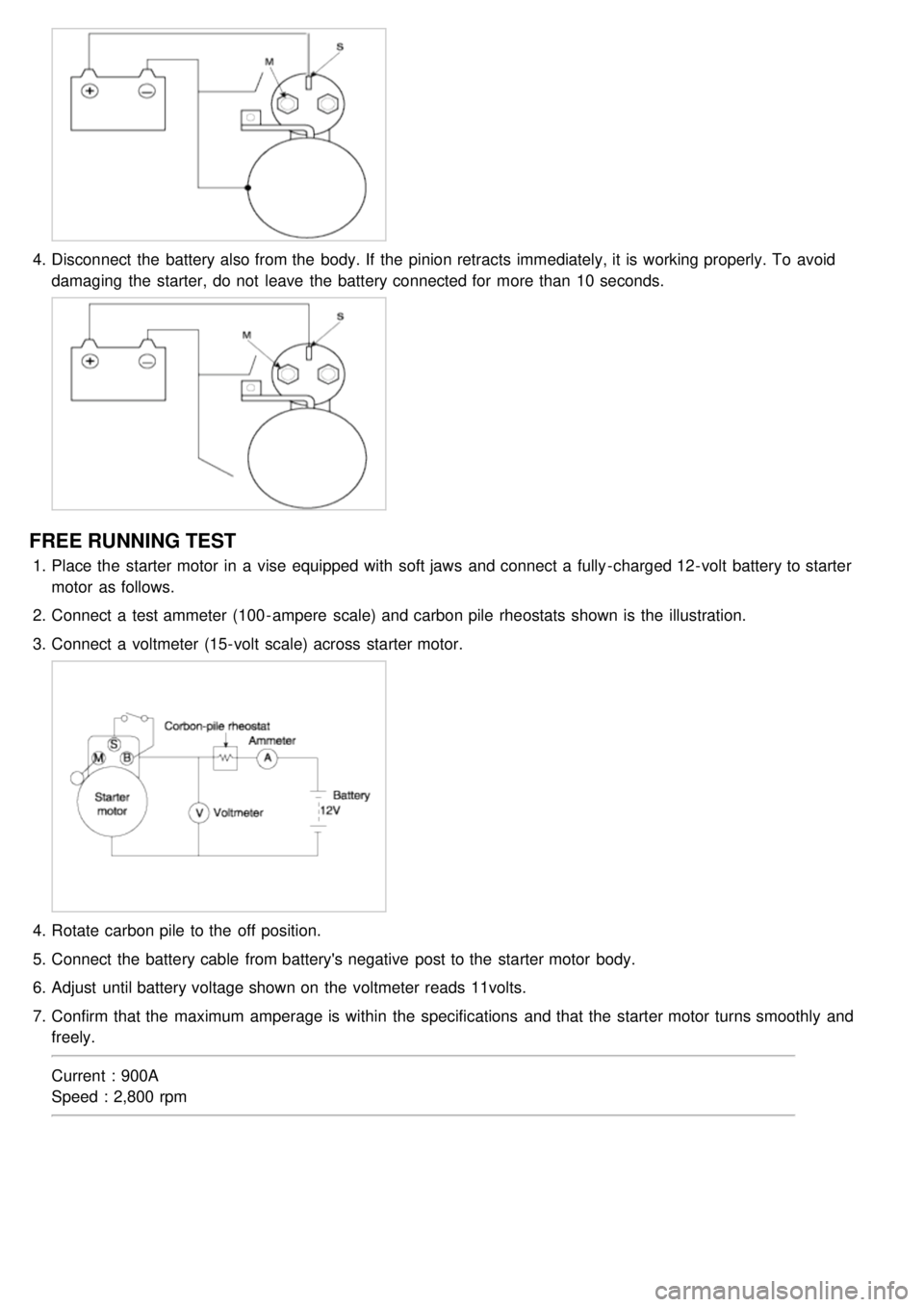
4.Disconnect the battery also from the body. If the pinion retracts immediately, it is working properly. To avoid
damaging the starter, do not leave the battery connected for more than 10 seconds.
FREE RUNNING TEST
1.Place the starter motor in a vise equipped with soft jaws and connect a fully - charged 12- volt battery to starter
motor as follows.
2. Connect a test ammeter (100 - ampere scale) and carbon pile rheostats shown is the illustration.
3. Connect a voltmeter (15- volt scale) across starter motor.
4.Rotate carbon pile to the off position.
5. Connect the battery cable from battery's negative post to the starter motor body.
6. Adjust until battery voltage shown on the voltmeter reads 11volts.
7. Confirm that the maximum amperage is within the specifications and that the starter motor turns smoothly and
freely.
Current : 900A
Speed : 2,800 rpm
Page 178 of 1575

Starter